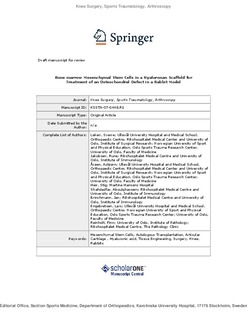| dc.contributor.author | Løken, Sverre | |
| dc.contributor.author | Jakobsen, Rune B. | |
| dc.contributor.author | Årøen, Asbjørn | |
| dc.contributor.author | Heir, Stig | |
| dc.contributor.author | Shahdadfar, A. | |
| dc.contributor.author | Brinchmann, J. E. | |
| dc.contributor.author | Engebretsen, Lars | |
| dc.contributor.author | Reinholt, Finn P. | |
| dc.date.accessioned | 2009-08-14T07:00:10Z | |
| dc.date.issued | 2008-07-01 | |
| dc.identifier | Seksjon for idrettsmedisinske fag / Department of Sports Medicine | |
| dc.identifier.citation | Knee Surgery, Sports Traumatology, Arthroscopy. 2008, 16(10), 896-903 | en |
| dc.identifier.issn | 0942-2056 | |
| dc.identifier.uri | http://hdl.handle.net/11250/170479 | |
| dc.description | I Brage finner du siste tekst-versjon av artikkelen, og den kan inneholde ubetydelige forskjeller fra forlagets pdf-versjon. Forlagets pdf-versjon finner du på www.springerlink.com: http://dx.doi.org/10.1007/s00167-008-0566-2 / In Brage you'll find the final text version of the article, and it may contain insignificant differences from the journal's pdf version. The original publication is available at www.springerlink.com: http://dx.doi.org/10.1007/s00167-008-0566-2 | en |
| dc.description.abstract | The purpose of this study was to evaluate the efficiency of using mesenchymal stem cells (MSC) in a hyaluronan scaffold for repair of an osteochondral defect in rabbit knee. Bone marrow was harvested from the posterior iliac crest in 11 New Zealand White rabbits. MSC were isolated and cultured in autologous serum for 28 days and transferred to a hyaluronan scaffold 24 h prior to implantation. A 4 mm diameter and 1.5 mm deep defect was created in the medial femoral condyle of both knees and the scaffold with MSC was implanted in one knee while an empty scaffold was implanted in the contra-lateral knee. After 24 weeks the rabbits were killed and histological sections were subjected to semiquantitative and quantitative evaluation by observers blinded regarding treatment modality. High degree of filling was obtained, but there was no statistically significant difference between the two treatments. However, there was a tendency for a better quality of repair in the MSC treated knees. No hypertrophy was observed by either method. MSC in a hyaluronan scaffold may be a promising treatment approach, but further studies are needed to determine the best combination of scaffold and cells. | en |
| dc.format.extent | 1071065 bytes | |
| dc.format.mimetype | application/pdf | |
| dc.language.iso | eng | en |
| dc.publisher | Springer | en |
| dc.subject | mesenchymal stem cells | en |
| dc.subject | autologous transplantation | en |
| dc.subject | articular cartilage | en |
| dc.subject | hyaluronic acid | en |
| dc.subject | tissue engineering | en |
| dc.subject | surgery | en |
| dc.subject | knee | en |
| dc.subject | rabbits | en |
| dc.title | Bone marrow mesenchymal stem cells in a hyaluronan scaffold for treatment of an osteochondral defect in a rabbit model | en |
| dc.type | Peer reviewed | en |
| dc.type | Journal article | en |
| dc.subject.nsi | VDP::Medical disciplines: 700 | en |
| dc.source.pagenumber | 896-903 | en |
| dc.source.volume | 16 | en |
| dc.source.journal | Knee Surgery, Sports Traumatology, Arthroscopy | en |
| dc.source.issue | 10 | en |
